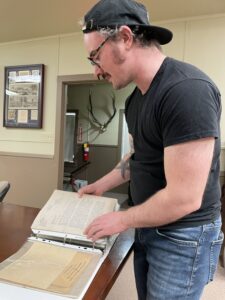
By LORI TOBIAS/Oregon ArtsWatch
LINCOLN CITY — Nearly 40 years ago, an 83-year-old retiree offered an old hand stitched quilt to a local museum accompanied by a couple of notes explaining its history. Today, the quilt tells the story of a woman born into slavery, a beloved and skilled quiltmaker whose time on this Earth might have vanished if not for the woman who treasured her memory.
The quilt is now the centerpiece of the North Lincoln County Historical Museum’s latest exhibit, Uncovering the History Behind Ziller’s Quilt — the story behind a crazy quilt donated to the museum in 1989 and kept in storage since.
Museum executive director Chris Melton happened upon notes about the quilt about two years ago while hosting the Oregon Coastal Quilters Guild. Guild members come to the museum every year and document details about old quilts people bring to the museum.

As the guild always documents a few of the museum’s quilts, Melton went looking to see if there were any that hadn’t been done yet. That’s when he found the notes about the quilt “made by a Black woman in the 1800s,” and pulled it from storage.
The quilt belonged to Anna Harrington, born in 1905 and raised in Lostine in eastern Oregon, who donated it after retiring in Lincoln Beach. The quilt top had been made by Ziller, and lined by Harrington’s mother, Emma Lilly Poe.
Notes left with the quilt explained that it had been made by a “colored person” that Harrington’s father, Andrew Jackson Poe, called “Zillah” (Ziller). The note also explained that when Poe was a boy, the family moved to Lostine; Ziller, lonely for Poe and his family, often wrote to him. Years later, when Andrew Jackson Poe developed rheumatism brought on by working at his sawmill “He sent for her because she was lonely and wanted to be with him.”
While it’s likely Ziller was Anna Harrington’s nanny, the true nature of Poe and Ziller’s relationship will never be known. What is known is that Ziller was with the Poes from the time Harrington was a baby.
In 2024, Melton displayed the quilt at a Juneteenth event hosted by Oregon Black Pioneers at the museum.
“Stories like this are incredibly rare in early Oregon history,” Melton said. “Oregon’s Black exclusion laws prevented many Black people from moving to the state for a long time, and the mainstream narrative still is that Black people just didn’t live here at all, which is simply not true.

“When I come across a discovery like this, it’s important for me to share it and show that all kinds of people have lived here and helped shape Oregon into the place it is today. We still don’t have a lot of stories about Black people in the area, and I thought this one should be told even if all I had was a snippet of a recollection from the time the donor was a little kid,” Melton said. “It is a really beautiful artifact.”
Ziller’s story might have ended with the small exhibit had it not been for Oregon Black Pioneers, which encouraged Melton to continue his research and offered funds to help. Melton delved deeper, even traveling to Wallowa County in search of more about Ziller.
“There are so many ways you can go, and it turns into a treasure hunt, and you feel like you’re a detective trying to track down people — in the past, which is even harder,” Melton said.
Melton was able to find records indicating that Andrew Jackson Poe had been born in 1864 in Virginia and by 1880, had moved with his family to Missouri.
“I was able to locate a Zilla Smith in the Census records in Missouri, living a couple houses away from the Poe family,” Melton said. “She was 40 years old, and she was living with Elijah Compton, an 80-year-old white man who had been a long-time enslaver. She was probably born into slavery. He may have been her father. … It’s very sketchy. His name was spelled completely differently every single Census he was ever found in — Elijah or Elihu Compton. I believe there’s a connection with the Poe family back in Virginia. He was an early homesteader and I’m fairly certain the Poe family moved from Virginia to Missouri to work with him on a farm before they came to Oregon.”

Poe moved to Portland 5 to 10 years after Ziller joined him in Oregon, and that’s where Melton’s search for Ziller ended. It’s possible she died in Lostine, although Melton found no record of her at the cemetery, nor did he find any mention of her in Portland records, but it seems likely she moved in the 10-year gap between Censuses.
Melton’s research eventually took him to the Wallowa History Center, where staff was able to direct him to the Poe family property.
“They were really helpful … the director of the history center lived adjacent to the plot of land that the Poes had homesteaded, so she was able to give me permission to go explore.”
The director didn’t know of a sawmill on the property but called a friend who’d grown up in Lostine. When she asked if he knew if there had been a sawmill there, “He said, ‘Oh yeah, of course. I remember when I was a kid, the bears used to den in the piles of sawdust’,” Melton said. “Things like that really helped paint a picture of a place, even if I couldn’t find Ziller herself.”
While he couldn’t find her cemetery plot and much of Ziller’s history remains open to conjecture, the quilt she left behind tells us she was loved, loved enough for a small child to carry her handiwork with her for nearly all her years.
Anna Harrington died the year after donating the quilt.
“The quilt is hand sewn, and it’s so beautiful,” Melton said. “It has a lot of different types of fabric, a lot of velvet. It looks like she probably recycled very nice clothing. There’s a lot of initials in it, which correspond with people in the family. And there are pictures … a little cat … a little guy fishing. It’s just a really, really beautiful quilt. I’m excited to be able to have it on display.”
- This story was originally published by our community partner Oregon ArtsWatch. For more arts news coverage go to Oregon ArtsWatch
- Lori Tobias is a longtime Newport-based journalist and author who can be reached at ltwriter0815@gmail.com



















I was given a quilt made by my Grandmother. I gave it to relatives whose home is more temperature-and-humidity stable~ my coastal house can get cold and damp at times, not good for fabric treasures. They display it proudly, and I’m happy for that. There is not only sentimental value to the quilt, but it is almost a century old, and made of fabrics and textile designs that we don’t see today. I love the story of Ziller’s quilt. It would make a nice movie!
If A.J. Poe retained a Southern accent when he moved to Lostine, he might indeed have called the creator of the quilt “Zillah” (Zilla), which is an actual name with interesting origins and meanings. [I was curious and did some research, too. “Andrew Jackson Poe* was born on 12 December 1864, in Tazewell, Virginia… He had at least 4 daughters with Emma Elizabeth Lilly*. He lived in Lostine, Wallowa, Oregon, United States in 1910 and Wallowa, Oregon, United States in 1920. He died on 28 December 1932, in Portland.”
~source: Family Search
*names mentioned in this article]